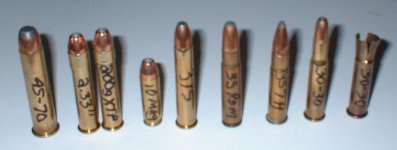Magnum Wheel Man
New member
as I've posted before, I'm getting ready to reload, after a several year break, during that break, my father in law ( a very big time collector & reloader ) died, & we inherted his collection & loading stuff, along with my adding alot of new stuff over those years... so "new to me" is the bullet casting stuff ( & bulk lead to cast ), Lubrisizer, & a more extensive "library" of dies, cartridges, powders & primers...
( for example... after combining his stuff with my old stuff, & things I bought in the many years that I didn't reload, I now have 38 different sets of dies, & need 17 more to cover all the cartridges I currently have guns to chamber )
my question... ( this time ) is about primers...
my father in law had alot of them, all stored in ammo cans, with silica jell packs in the cans, so I'm sure they are all good... ( I just read the ammo can debate... I had been storing mine on a shelf in the original packaging, his had been stored for decade ( s ) in the basement in ammo cans... I've posted on that thread already, so lets discuss that over there, & keep this thread about my questions below )
but...
some are very old ( maybe collectable) a couple that come to mind are the CCI primers, before they shortened the name to just the initials , & at least one box of Remington primers before they went to 4 color packaging, in a 2 color box... several of these are full 1000 packs...
, & at least one box of Remington primers before they went to 4 color packaging, in a 2 color box... several of these are full 1000 packs...
if these are worth more than new primers ( collectable ) please let me know...
if they are not collectable, how have primers changed over the years, could these be "better" than new primers, or have the new ones been improved over these old primers, or if I develope a load around them, & use them up, can I expect that new replacements will fire exactly the same ???
& while we are on the subject of prmers, what the heck is a Bench Rest primer... at least, how is it different than it's standard counterpart ??? more consistant???, hotter, but not as hot as a magnum primer??? cup softer, cup harder ??? just more expensive, but the same ???
thanks for your comments...
( for example... after combining his stuff with my old stuff, & things I bought in the many years that I didn't reload, I now have 38 different sets of dies, & need 17 more to cover all the cartridges I currently have guns to chamber )
my question... ( this time ) is about primers...
my father in law had alot of them, all stored in ammo cans, with silica jell packs in the cans, so I'm sure they are all good... ( I just read the ammo can debate... I had been storing mine on a shelf in the original packaging, his had been stored for decade ( s ) in the basement in ammo cans... I've posted on that thread already, so lets discuss that over there, & keep this thread about my questions below )
but...
some are very old ( maybe collectable) a couple that come to mind are the CCI primers, before they shortened the name to just the initials
if these are worth more than new primers ( collectable ) please let me know...
if they are not collectable, how have primers changed over the years, could these be "better" than new primers, or have the new ones been improved over these old primers, or if I develope a load around them, & use them up, can I expect that new replacements will fire exactly the same ???
& while we are on the subject of prmers, what the heck is a Bench Rest primer... at least, how is it different than it's standard counterpart ??? more consistant???, hotter, but not as hot as a magnum primer??? cup softer, cup harder ??? just more expensive, but the same ???
thanks for your comments...
Last edited:

